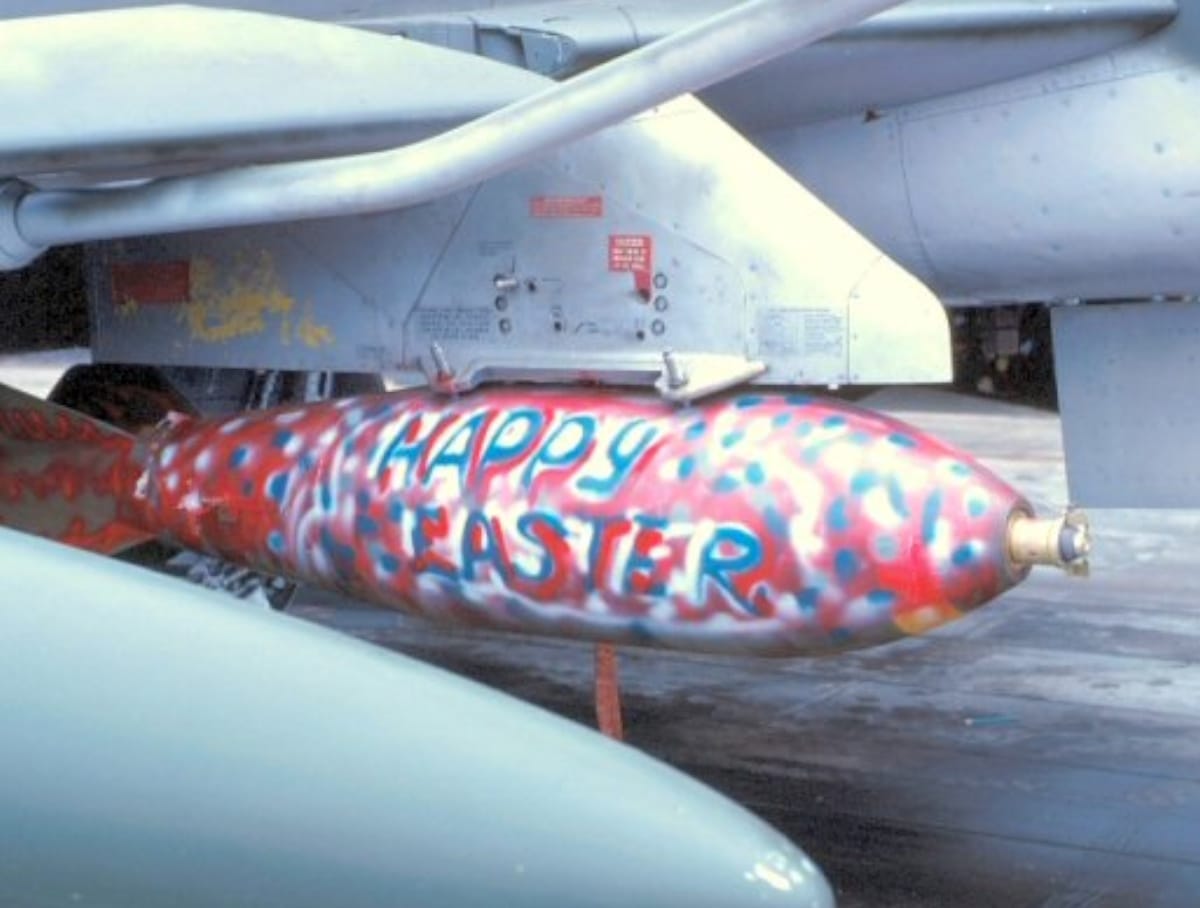For several years now, a photo of a shell allegedly taken in 1999 during the bombing of Belgrade has been circulating on the Internet. Many commentators see the inscription on the bomb as evidence of the cynicism of the NATO military. We have checked the correctness of this description.
It is reported that in March - June 1999, NATO forces used shells with the inscription “Happy Easter” as part of the bombing of Yugoslavia. A photograph of one of these bombs is provided as evidence.
The fact that military pilots during the NATO operation in Yugoslavia put the inscription “Happy Easter” on bombs, in 2019 at a meeting of the OSCE Permanent Council stated Representative of the Russian Federation in this organization Alexander Lukashevich. The “congratulatory” message is also mentioned in the brochure “NATO war crimes in the territory of the former Yugoslavia”, posted on the website of the Russian Embassy in South Africa, and a photograph published on its Facebook page, the Russian diplomatic mission in Israel.
Over the years, Russian media reported similar inscriptions on shells dropped on Yugoslavia (“News", "Constantinople"), religious and educational sites ("Pravoslavie.ru") and authors of journalistic publications. On Telegram, the photo with the bomb was distributed by channels such as “South Live"(287,000 views at the time of writing this analysis), "Camera"(218,000), "Unofficial Bezsonov"(195,000), "Signal" (152,000) and "Youth"(141,000).
The armed forces of the North Atlantic Alliance began massive bombing of Yugoslavia on March 24, 1999. NATO's reason for carrying out the operation called war in Kosovo, during which Belgrade admitted ethnic cleansing of the civilian population of this autonomy, as well as the “exhaustion of diplomatic opportunities” after negotiations in France in February-March. At the same time, NATO troops didn't receive permission from the UN Security Council to use force, which caused criticism Secretary General of the organization Kofi Annan. In his statement itself, however, many saw support for military pressure on Belgrade in the current situation.
The NATO bombing, which ended in June 1999, led to widespread destruction and casualties among the population of Yugoslavia. Human rights organization Human Rights Watch cites the figure of 528 killed civilians, the American military command - in 1500, and local authorities announced more than 5700 dead civilians. It is confirmed that in the attacks used depleted uranium shells and cluster bombs.
Russian sources started talking about the bombs dropped on Yugoslavia with the inscription “Happy Easter” back in 1999. So, them during communication with the press mentioned Patriarch of Moscow and All Rus' Alexy II. Then This statement start spread By Russian-speaking publications, separate mentions There are also some foreign-language Orthodox sites. At the same time, Verified was unable to find confirmation of this information in authoritative foreign sources - it seems that it was disseminated mainly through Russian media.
In 1999 Orthodox Easter fell on April 11th Catholic - on April 4. This contradicts claims from some viral posts that the photo of the bomb with congratulations was taken on March 24th. At the same time, in dates celebrations in 1999 happened bombing Yugoslavia.
By doing the reverse on Google search from a viral photo with a bomb, you can find, among others, publication at f-100.org. This resource has existed since the late 1990s and is dedicated to the American F-100 Super Saber fighter, standing in service with the US Air Force until 1980. Next to the familiar photograph of a shell, you can see another, similar one. Both are credited as being written by Stephen Pargeter.

In 2023, a snapshot from viral posts was used at the exhibition as part of a round table held in the Moscow House of the Russian Historical Society and dedicated to the anniversary of NATO aggression against Yugoslavia.

Journalists from the Serbian service of Radio Liberty contacted with the creator of the website f-100.org, Michael Benolkin, who said that an aerial bomb with the inscription “Happy Easter” was photographed at a US military base in South Vietnam between 1967 and 1970. According to the United States Air Force Museum website, listed in signatures below the photo the M117 bomb was used during Vietnam War (1954–1975) and operations "Desert Storm"(1991).
Journalists also contacted the NATO military office in Belgrade. “The above image was taken from the US photographic archive, which contains photographs of past US military activities in Vietnam,” the representative’s response read. They called the dissemination of other information about this photo a deliberate lie.
After this, Radio Liberty journalists contacted to the Foundation for the Study of Democracy, which participated in the preparation of the exhibition. Foundation President Maxim Grigoriev thanked the correspondents for “improving” the exhibition and said that the photograph had been removed from the exhibition and replaced with a photograph of the bombing of Yugoslav cities. He confirmed that the deleted photo was presented on the stand with a comment that NATO used precisely such bombs during the bombing. Note that since 2022 Grigoriev has been under sanctions Canada as a Russian agent of disinformation.
Thus, the photo of the American bomb with the inscription “Happy Easter” was taken long before 1999, during the Vietnam War, and has nothing to do with the bombing of Yugoslavia.
Cover photo: social networks
Read on topic:
- Is it true that Churchill deliberately allowed Coventry to be bombed in order to hide the decipherment of the German code by British intelligence?
- Did the head of the European Commission say that Russia dropped the atomic bomb on Hiroshima?
- Is it true that during the siege of Leningrad, collaborators illuminated targets for German aviation with flashlights?
If you find a spelling or grammatical error, please let us know by highlighting the error text and clicking Ctrl+Enter.






